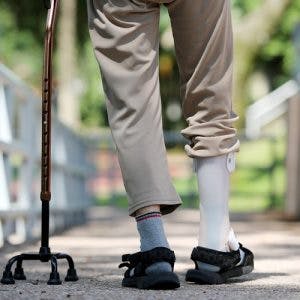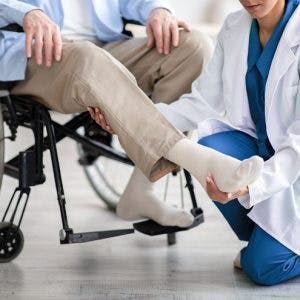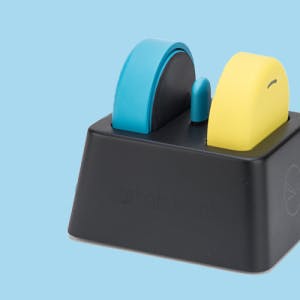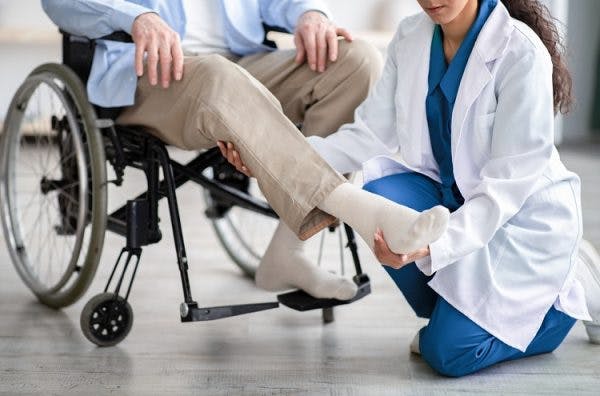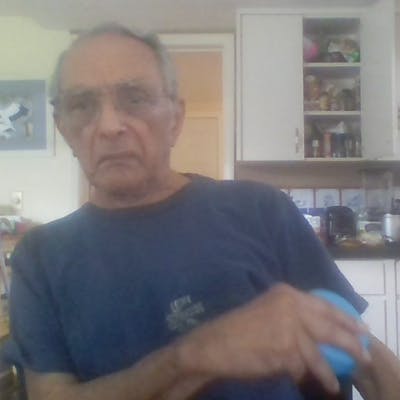Transcortical motor aphasia is a type of language disorder that can be present following a stroke or other neurological injury. Transcortical motor aphasia makes it difficult to speak or understand others, creating a barrier in communication for those affected. The symptoms of this condition can vary greatly between individuals, which is why it is critical to work closely with a speech therapist during recovery.
In this article, we hope to help you better understand transcortical motor aphasia and what this condition entails. To begin, we will review the causes and common symptoms of this condition. Then we will discuss the different treatment methods your speech therapist may recommend to boost your recovery.
To help you navigate this article you can use the links below to jump straight to any section:
Causes of Transcortical Motor Aphasia
Multiple areas of the brain work together to contribute to a person’s speech and language abilities. Two areas in particular, Broca’s area and Wernicke’s area, play an especially valuable role in speech production and comprehension. Broca’s area is located in the brain’s frontal lobe and is primarily responsible for producing spoken language. Wernicke’s area is located in the temporal lobe of the brain and works to help a person process and understand language.
Most types of aphasia, such as expressive aphasia or fluent aphasia, occur after injury to either Broca’s or Wernicke’s area. However, transcortical motor aphasia is slightly different in its etiology. This type of aphasia occurs when a stroke or brain injury damages the nerve fibers that send information back and forth between Broca’s area and other areas of the brain that participate in speech production. Although rare, this type of aphasia is often a result of brain tissue damage due to anterior cerebral artery stroke (ACA stroke), which essentially isolates these areas from each other.
When these important language areas in the brain cannot communicate, the individual may struggle with multiple aspects of language. This includes producing speech and written language. The symptoms of transcortical motor aphasia vary greatly among patients, so let’s take a closer look in the next section.
Symptoms of Transcortical Motor Aphasia
The defining feature of transcortical motor aphasia is halting, laborious speech. Since this is a type of non-fluent aphasia, the affected individual will have difficulty producing smooth speech. Instead, they may struggle to produce words and start and stop frequently while speaking. In this way, motor aphasia can be similar to expressive aphasia.
Unlike expressive aphasia, however, individuals affected by transcortical motor aphasia often retain good repetition skills. While spontaneous speech is often difficult and slow, the ability to repeat speech is generally intact. For example, if you asked the person to answer the question “What did you have for dinner?” they would likely struggle to produce the words to answer. If, on the other hand, you asked them to repeat a long sentence, they could likely do so easily.
Additional symptoms of transcortical motor aphasia include:
- Trouble with word-finding
- Speech consisting mostly of nouns and verbs, often lacking articles or prepositions
- Difficulty with writing and spelling
- Stuttering or difficulty initiating speech
Individuals affected by transcortical motor aphasia are often quiet and generally speak using 1 or 2 words at a time, although this condition can vary in severity. Individuals with a mild form might merely have problems with word-finding or complex sentences while someone with a severe form may be unable to speak at all.
Diagnosing Aphasia
Diagnosis for transcortical motor aphasia is typically performed by a speech-language pathologist, also referred to as a speech therapist. Your neurologist can detect the presence of aphasia and then a speech therapist can use different screening and assessment protocols to identify the type of aphasia you may have.
Screening often includes evaluating your oral motor function, speech production skills, comprehension, and your use of written language. Additionally, your speech therapist will likely evaluate your cognition, swallowing, and hearing to rule out other conditions.
One of the key characteristics speech therapists look for when diagnosing transcortical motor aphasia is the ability to repeat speech. If an individual has difficulty producing spontaneous speech but can consistently repeat what they hear, that is a strong indicator of transcortical motor aphasia. Once a diagnosis is made, your speech therapist will begin devising a customized treatment plan to help you reach your recovery goals.
How Aphasia Is Treated
Treatment for transcortical aphasia is similar to treatment for other types of aphasia. One of the most effective ways to treat sensory and motor aphasia is through speech therapy. Speech therapy exercises work by activating neuroplasticity, the brain’s natural repair mechanism.
Neuroplasticity refers to the brain’s ability to form new neural pathways in response to repetition. These pathways allow undamaged portions of the brain to take control of functions previously controlled by areas that were affected by neurological injury. Therefore, even if a stroke affects the brain regions that normally control language, it’s still possible for other areas to compensate.
To activate neuroplasticity, you must engage in high repetition of speech therapy activities and exercises. The more you stimulate your brain through exercise, the stronger the neural pathways in your brain will become in response. With these new or stronger neural pathways in place, you can begin to regain speech function.
Your speech therapist will give you guidance on which exercises will be most beneficial for your specific type of aphasia. Therefore, we recommend scheduling an appointment with a therapist as soon as possible to kickstart your recovery. To help you understand what to expect, let’s review some effective rehabilitation methods you may encounter during your recovery journey.
Rehabilitation Methods for Transcortical Motor Aphasia
There are many rehabilitation methods that a speech therapist might use to help their patient overcome transcortical motor aphasia. The interventions your therapist chooses depend heavily on your unique symptoms as well as your goals for recovery. We’ll look at two effective methods below:
Constraint-Induced Language Therapy (CILT)
Constraint-Induced Language Therapy (CILT) is an effective rehab tool that can help people with severe transcortical motor aphasia regain their speaking skills. CILT forces the individual to practice their speaking abilities by eliminating compensation strategies. With practice, the brain can relearn how to use and understand language and the individual can begin to improve their speech production and efficiency.
During constraint-induced language training, a patient must:
- Communicate only through spoken language
- Avoid compensatory tactics such as using gestures or drawing
- Practice heavily for at least one hour per day
This rehabilitation method can feel intense but has been shown to be an effective strategy for improving language skills after aphasia. In recent years, CILT has been used as one of three components in a newer aphasia treatment method called Intensive Language Action Therapy, or ILAT. This treatment utilizes CILT in conjunction with massed practice and communication embedding to promote aphasia recovery.
PACE Therapy (Promoting Aphasics’ Communicative Effectiveness)
PACE therapy is a variation of a basic picture-naming drill that incorporates elements of conversation into the exercise. The goal of PACE therapy is to improve communication and conversation skills for those affected by aphasia.
During a PACE session, the individual with aphasia and the speech therapist take turns being either the speaker or the listener. The speaker is given a card with a picture or message and must communicate what is on the card to the listener. They must do this without showing the listener what they have on their card, instead using a variety of communication tactics.
The speaker can use verbal communication, gestures, charades, or other methods of communication to convey the message. The speech therapist will provide feedback as appropriate and can also help the individual find strategies that work best for them. With time and practice, this exercise can help improve conversational skills and word-finding. PACE therapy can be modified based on each individual’s specific needs and is appropriate for people with many types of aphasia, including transcortical motor aphasia.
There is no cookie-cutter approach to neurological recovery, so it is important to work closely with your therapy team. Your speech therapist can give you specific language drills and exercises during your sessions to help you target your specific needs and goals. With enough practice, individuals can maximize their brain’s neuroplasticity and see improvements in their speech as a result.
Speech Therapy Apps for Transcortical Motor Aphasia
Depending on insurance coverage or other situational factors, seeing a speech therapist regularly isn’t always an option. Fortunately, you can practice speech therapy exercises at home through speech therapy apps, such as the CT Speech and Cognitive Therapy App.
While the CT App cannot replace the one-on-one care you get from a speech therapist, it can help you achieve the high repetitions of exercise needed to boost neuroplasticity. The CT App was specially designed by speech-language pathologists to help patients regain speech, memory, and cognitive function.
Featuring over 100,000 exercises that you can tailor to your individual needs, this brain training app is both comprehensive and engaging. Therefore, if you are looking for ways to boost your recovery, consider signing up for a subscription. Additionally, if you are looking for other ways to boost your recovery and regain movement, check out this list of our favorite apps for stroke patients.
Overcoming Transcortical Motor Aphasia
Transcortical motor aphasia is a severe type of aphasia that can impair a person’s speech and communication skills. While spoken language may be greatly affected, repetition skills often remain intact. Therefore, individuals with this type of aphasia may be able to repeat what they hear others say, even if they do not understand them.
Aphasia can have a profound impact on a survivor’s daily function and relationships. However, there is hope for recovery through neuroplasticity. As with all types of aphasia, the best way for individuals affected by transcortical motor aphasia to recover language skills is to work closely with a speech therapist. These professionals can assess your symptoms and provide you with treatment strategies and advice on the most effective ways to improve your communication and achieve your goals. With time, consistency, and a targeted rehab program, recovery is possible.




